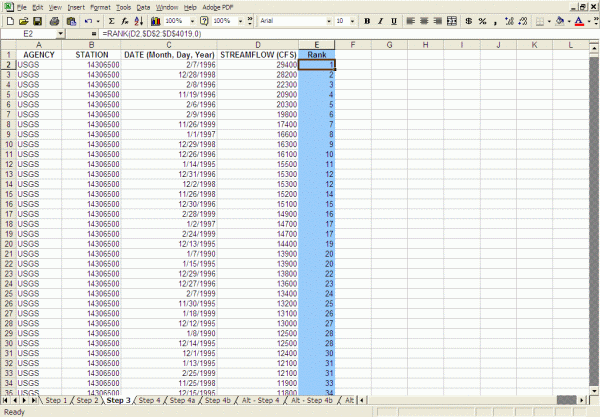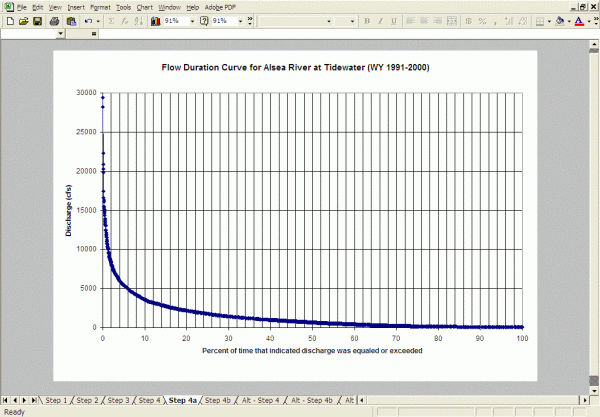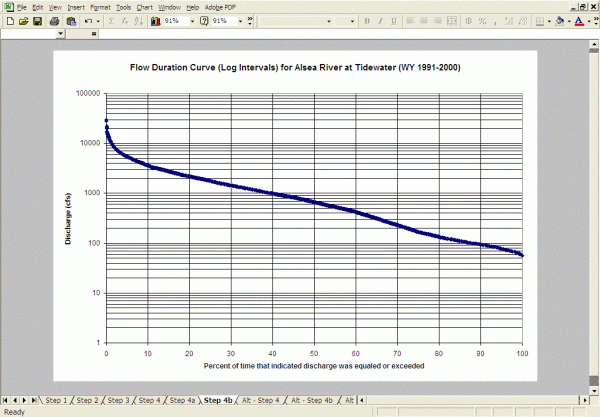Analysis Techniques: Flow Duration Analysis Tutorial
|
Information to get started:
- The lesson below contains step-by-step instructions and "snapshots" of what each step
looks like when carried out in a Microsoft Excel workbook. Blue shading of information
in the Excel illustrations denotes changes made from the previous step. Dots placed in
three consecutive rows indicate that a portion of data is hidden from sight.
- You can download an Excel workbook containing the complete data set by clicking on the
"Download Data" link below. It contains
each calculation step on a separate worksheet. To move between steps, click on the
tabs at the bottom of the excel window.
- When you download the file, it may open in your browser window. You may wish to use the
"save as" function to save the file to a local drive and then reopen it in Excel. This
will make it easier to flip between the online lesson and the example workbook.
- Finally, we want to remind you that the techniques explained on this site are statistically
based; therefore results must be viewed as predictions and not as facts. Please use
the techniques and the information obtained from them responsibly!
|
Step 1: Select the time step value (day,
month, etc.) and download the chronological record of discharge
- For the Alsea Example and Tutorial, the analysis will
be done using a daily time step.

Step 2: Compute the total number of time
step intervals in the period of record.

Step 3: Rank discharge by magnitude.

Step 4: Calculate the percent of time that each discharge is equaled or
exceeded.
- Create a new column called "Exceedence Probability". As noted on the
flow duration page, the exceedence probability can be calculated as follows:
P = 100 * [ M / (n + 1) ]
P = the probability that a given flow will be equaled or exceeded
(% of time)
M = the ranked position on the listing (dimensionless)
n = the number of events for period of record (dimensionless)
Create
a formula to calculate this value for each record using the information
from Step 2 (=(E2/('Step 2'!$D$4020+1))*100).

- Graph the "exceedence probability" versus the discharge. The graph can
have either linear or logarithmic axes.


Alternative Approach:
Before spreadsheet programs were common, flow duration curves were constructed
by grouping the data into discharge size classes (bins). This avoided the
once time-consuming tasks of sorting, ranking, and graphing the individual
discharge records. With modern spreadsheet programs, these steps can be done
quickly
and flow duration curves can be created as we described above.
However, some flow duration analyses are still made by grouping data into
size classes. The steps below will guide you through this alternative approach.
Alternative Step 3: Rank discharge by magnitude
and calculate maximum and minimum discharge.

Alternative Step 4: Divide the range of average values
into classes.

- It is recommended to have between twenty to thirty class intervals for
the period of record. Classes can either be equal interval or based on
log cycles.
Log
cycles are often used to sort data because the probability of choosing appropriate
interval spacing is higher than if the data were separated into 20 to 30
equal classes. If
improper intervals are chosen, the amount of information the flow duration
curve can provide is diminished.
- For
the equal interval method, determine the discharge range for each class
by dividing the max discharge value by the desired number of size classes.
In the
tutorial
data, the max discharge value is 29400 cfs. That value divided by
20 is 1470.
So for twenty size classes with equal intervals
in each class, the smallest size class will be discharges between 0-1470
cfs. The second size class will be 1471-2940 cfs and so on, up to the
max value.
- For classes based on log cycles, select classes of discharge values
based on a spacing of 1, 1.5, 2, 3, 4, 5, 7, 10, or on multiples of
10 of these values. For the tutorial data,
the size classes will be 10-14 cfs, 15-19 cfs, 20-29 cfs on up to
20,000-29,999 cfs.
- Use the ranked data to count the total number of occurrences of values
in each class.
20 Equal Class Intervals:

Using Log Cycles:

Alternative Step 5: Summarize the results in a table.

- A plot of the total number of occurrences in each class versus discharge
gives a frequency distribution.


Alternative Step 6: Beginning with the upper boundary
of the highest class, add up the total number of values that are greater
than the lower boundary for each successive class.



Alternative Step 7: The cumulative number of occurrences
is converted to a percentage of the time.
- Divide the values developed above by the total number of time steps
from Step 2; this gives the frequency with which the lower values of each
class have been equaled or exceeded in the period of record.


Alternative Step 8: Finally the diagram is turned
so that discharge is given on the vertical axis and exceedence frequency
is given on the horizontal axis.


|


